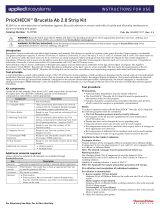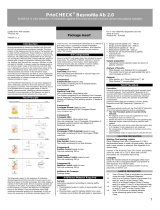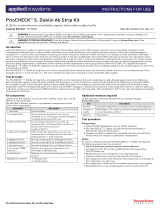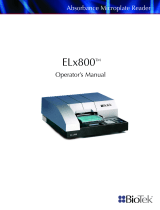Page is loading ...

PrioCHECK® Brucella Ab 2.0
ELISA for in vitro detection of antibodies against Brucella abortus in serum and milk of cattle and
Brucella melitensis in serum of sheep and goats
5 plate kit for 460 samples
©Prionics AG
Version 1.3_e
For in-vitro veterinary diagnostic use only
Store at 5±3°C
Product No.: 7610700
Introduction
Brucellosis occurs world wide and affects both humans
and animals. The disease is caused by bacteria of the
genus Brucella (Gram-negative cocco-bacilli). The
genus comprises 6 species: B. abortus (7 biovars), B.
melitensis (3 biovars), B. suis (5 biovars), B. ovis, B.
canis, B. neotomae and B. maris. The main reservoir
for B. abortus is cattle, the main reservoir for B. meli-
tensis are sheep and goats. Many serological tests
have been developed for the routine diagnosis of
brucellosis. Whatever test is used, one should be
aware that cross-reactions with other Gram-negative
bacteria such as Francisella tularensis, Campyloba-
cter, Salmonella, Pasteurella, Yersinia enterocolitica
0:9, Escherichia coli O:117 and 0:156 may occur.
After infection with B. abortus, antibodies of the IgM
class appear and are followed by antibodies in the IgG
classes (IgG1 and IgG2). The PrioCHECK® Brucella
Ab 2.0 detects antibodies of the IgG1 class in serum
and milk. The test meets the requirements of the EU
directive 64/432. The PrioCHECK® Brucella Ab 2.0
can be used for: surveillance and monitoring pro-
grams; individual and herd diagnosis.
Test Principle
A microtiterplate is coated with purified extract of the
LPS of Brucella. Serum samples or milk samples are
dispensed in the coated wells of a microtiterplate.
Antibodies, directed against Brucella abortus, that are
present in the test sample, bind to the antigen during
incubation. The bound antibodies are detected using
an anti-bovine IgG monoclonal antibody, conjugated to
the enzyme horseradish-peroxidase. Subsequently,
the bound conjugate is visualized by adding Chro-
mogen (TMB) Substrate. Color development meas-
ured optically at a wavelength of 450 nm shows the
presence of antibodies directed against brucellosis.
Kit Components
Store kit at 5±3°C until expiry date. See kit label for
expiry date. The shelf life of diluted, opened or recon-
stituted components is noted below, where appropri-
ate. Chemical hazard data are available in section
“Safety Regulations and R&S Statements” (Appendix
II).
Component 1
Test Plate
Five Test Plates.
Component 2
Conjugate (100x)
(100x concentrated, dilute before use)
One vial contains 0.65 ml Conjugate.
Diluted conjugate is not stable, prepare just before
use.
Component 3
Dilution Buffer (ready-to-use)
Three bottles containing 60 ml Dilution Buffer.
Component 4
Washing Fluid (25x)
(25x concentrated, dilute before use)
Two bottles containing 60 ml Washing Fluid.
Shelf life of washing solution: 1 week at 22±3°C.
Component 5
Positive Control (ready-to-use)
One vial contains 4.0 ml Positive Control.
Component 6
Negative Control (ready-to-use)
One vial contains 4.0 ml Negative Control.
Component 7
Chromogen (TMB) Substrate (ready-to-use)
One bottle contains 60 ml Chromogen (TMB) Sub-
strate.
Component 8
Stop Solution (ready-to-use)
One bottle contains 60 ml Stop Solution.
Additional Kit Contents:
- 10 plate sealers
- Package Insert
- Certificate of analysis
Additional Material Required
General:
Laboratory equipment according to national safety
regulations.
Analysis of Results:
Plate Reader e.g. Multiscan EX or equivalent.
The reader has to have an appropriate filter set to read
the plates at 450 nm.
Incubation:
Microplate Incubator.
Optional:
Plate washer e.g. Tecan EIA Tray Washer or
equivalent.
Dummy plates. We advice U-bottom shaped
plates (Greiner, art. nr. 650101). However,
also other non-binding plates or tubes can be
used.
Test Procedure
Precautions
National guidelines for working with animal samples
must be strictly followed. The PrioCHECK® Brucella
Ab 2.0 must be performed in laboratories suited for
this purpose.
Samples should be considered as potentially infectious
and all items which contact the samples as potentially
contaminated.
Chemical hazard data are available in section “Safety
Regulations and R&S Statements” (Appendix II).
Notes
To achieve optimal results with the PrioCHECK®
Brucella Ab 2.0, the following aspects must be consid-
ered:
The Test Procedure protocol must be strictly
followed.
All reagents of the kit must be equilibrated to
room temperature (22±3°C) before use.
Pipette tips have to be changed for every pipet-
ting step.
Separate solution reservoirs must be used for
each reagent.
Kit components must not be used after their
expiry date or if changes in their appearance are
observed.
Kit components of different kit lot numbers must
not be used together.
Demineralized or water of equal quality must be
used for the test.
SOLUTIONS TO BE MADE IN ADVANCE
Conjugate dilution
Prepare dilution of the Conjugate (100x) (Component
2) in Dilution Buffer (Component 3).
For one plate prepare 11 ml, add 0.11 ml Conjugate
(100x) to 10.89 ml of Dilution Buffer.
Note: The diluted conjugate must be prepared just
before use.
Washing solution
The Washing Fluid (25x) (Component 4) must be
diluted 1/25 in demineralized water and is sufficient for
a final volume of 3 liters of washing solution.
Stability of washing solution: 1 week at 22±3°C.
Note: see Appendix IV for sample preparation
procedure and storage
PRE-DILUTION AND INCUBATION OF
INDIVIDUAL SAMPLES
Pre-dilution in dummy plate
1.1 Bovine samples 1:10 pre-diluted
Dispense 90 µl of Dilution Buffer to the wells and
add 10 µl of bovine serum.
Sheep samples 1:5 pre-diluted
Dispense 80 µl of dilution buffer working solution
to the wells and add 20 µl of sheep serum.
Goat samples 1:2.5 pre-diluted
Dispense 60 µl of dilution buffer working solution
to the wells and add 40 µl of goat serum.
1.2 Shake the dummy plate gently.
Incubation in the Test Plate
2.1 Dispense 100 µl of the Positive Control (Compo-
nent 5) to wells A1 and B1 of the Test Plate
(Component 1).
2.2 Dispense 100 µl of the Negative Control (Com-
ponent 6) to wells C1 to D1 of the Test Plate.
2.3 Serum sample
Dispense 90 µl of Dilution Buffer to the remain-
ing wells and add 10 µl of the pre-diluted sam-
ple sera to each of the corresponding wells of
the Test Plate.
2.4 Milk sample
Dispense 100 µl undiluted milk samples (indivi-
dual or bulk) to the wells of the Test Plate.
2.5 Seal and shake the Test Plate gently.
2.6 Incubate the Test Plate 60±5 minutes at 22±3°C.
PRE-DILUTION AND INCUBATION OF POOLED
TEST SAMPLES
Pre-dilution in a dummy plate
1.1 Prepare a pool of 8 serum samples by mixing 10
µl of each individual serum. Once homogenized,
prepare a 1/25 dilution in Dilution Buffer. To pre-
pare this dilution we recommend adding 240 µl
of Dilution Buffer and 10 µl of the pool of 8 se-
rum samples in the dummy plate.
1.2 Shake the dummy plate gently.
Incubation in the test plate
2.1 Dispense 100 µl of the Positive Control (Compo-
nent 5) to wells A1 and B1 of the Test Plate
(Component 1).
2.2 Dispense 100 µl of the Negative Control (Com-
ponent 6) to wells C1 to D1 of the Test Plate.
2.3 Pooled bovine serum samples
Package Insert

PrioCHECK
®
Brucella Ab 2.0
Dispense 100 µl of the 1/25 diluted pooled
serum samples to the remaining wells of the
Test Plate.
2.4 Milk sample
Dispense 100 µl undiluted milk samples (indivi-
dual or bulk) to the wells of the Test Plate.
2.5 Seal and shake the Test Plate gently.
2.6 Incubate the Test Plate 60±5 minutes at 22±5°C.
Continue with the following procedure for both
individual and pooled samples.
INCUBATION WITH CONJUGATE
3.1 Empty the Test Plate and wash the plate 6 times
with 200-300 µl washing solution. Tap the plate
firmly after the last wash cycle.
3.2 Dispense 100 µl of the diluted conjugate to all
wells.
3.3 Seal the Test Plate and incubate 30±5 minutes
at 22±3°C.
INCUBATION WITH CHROMOGEN (TMB)
SUBSTRATE
4.1 Empty the Test Plate and wash the plate 6 times
with 200-300 µl washing solution. Tap the plate
firmly after the last wash cycle.
4.2 Dispense 100 µl of the Chromogen (TMB)
Substrate (Component 7) to all wells.
4.3 Incubate the Test Plate (in the dark) for 10
minutes at 22±3°C.
4.4 Add 100 µl of the Stop Solution (Component 8)
to all wells.
4.5 Mix the content of the wells of the Test Plate.
Note: Start the addition of Stop Solution 10 minutes
after the first well was filled with Chromogen (TMB)
Substrate. Add the Stop Solution in the same order
and the same pace as the Chromogen (TMB) Sub-
strate solution was dispensed.
READING OF THE TEST AND CALCULATING THE
RESULTS
5.1 Measure the optical density (OD) of the wells at
450nm within 15 minutes after color develop-
ment has been stopped.
5.2 Calculate the mean OD450 of the Positive Control
(wells A1 and B1).
5.3 Calculate the mean OD450 of the Negative
Control (wells C1 and D1).
5.4 Calculate the percent positivity (PP) of all the
test samples according to the formula below.
The OD450 of all samples are expressed as percent
positivity (PP) relative to the mean OD450 of the Posi-
tive Control (wells A1 and B1).
OD450 test sample
PP = --------------------------------------------------- x 100
Mean OD450 Positive Control
RESULT INTERPRETATION
Validation criteria
7.1 The mean OD450 of the Negative Control must be
< 0.2.
7.2 The mean OD450 of the Positive Control must be
≥1.000.
Note: Not meeting any of these criteria is reason to
discard the results of that specific test run.
Note: If the mean OD450 of the Positive Control is
below 1.000 possibly the Chromogen (TMB) Substrate
is too cold. In that case warm the solution to 22±3°C or
incubate up to 30 minutes.
Interpretation of the percent positivity
Bovine serum (individual) samples
PP < 40% (negative)
Brucella antibodies are absent in the test sample.
PP > 40% (positive)
Brucella antibodies are present in the test sample.
Bovine milk (individual or bulk) samples
PP < 25% (negative)
Brucella antibodies are absent in the test sample.
PP > 25% (positive)
Brucella antibodies are present in the test sample.
Bovine serum (pooled) samples
PP < 35% (negative)
Brucella antibodies are absent in the test sample.
PP > 35% (positive)
Brucella antibodies are present in the test sample.
Sheep serum (individual) samples
PP <25% (negative)
Brucella antibodies are absent in the test sample.
PP >25% (positive)
Brucella antibodies are present in the test sample.
Goat serum (individual) samples
PP <25% (negative)
Brucella antibodies are absent in the test sample.
PP >25% (positive)
Brucella antibodies are present in the test sample.
Serum samples in a positive pool need to be retested
individually.
Appendix I
Notice
This manual is believed to be complete and accurate
at the time of publication. In no event shall Prionics AG
be liable for incidental or consequential damage in
connection with or arising from the use of this manual.
Liability
Prionics AG warrants its products will meet their
applicable published specification when used in
accordance with their applicable instructions and
within the declared products life time. Prionics AG
makes no other warranty, expressed or implied. There
is no warranty of merchantability or fitness for a par-
ticular purpose. The warranty provided herein and the
data, specifications and descriptions of Prionics AG
products appearing in Prionics AG published cata-
logues and product literature may not be altered
except by express written agreement signed by an
officer of Prionics AG. Representation, oral or written,
which are inconsistent with this warranty or such
publications are not authorized and if given, should not
be relied upon.
In the event of a breach of the foregoing warranty,
Prionics AG’s sole obligation shall be to repair or
replace, at its option, the applicable product or part
thereof, provided the customer notifies Prionics AG
promptly of any such breach. If after exercising rea-
sonable efforts, Prionics AG is unable to repair or
replace the product or part, then Prionics AG shall
refund to the customer all monies paid for such appli-
cable product or part.
Prionics AG shall not be liable for consequential,
incidental, special or any other indirect damages
resulting from economic loss or property damage
sustained by any customer from the use of its prod-
ucts.
Prionics AG and Prionics Lelystad B.V. are ISO
9001:2000 certified companies.
Appendix II
Safety Regulations and R&S Statements
National Safety Regulations must be strictly fol-
lowed.
R&S Statements
Component 1
Test Plate
Hazard Code: This product is not classified according
to EU regulations.
Component 2
Conjugate (100x)
Hazard Code: This product is not classified according
to EU regulations.
Component 3
Dilution Buffer (ready-to-use)
Hazard Code: This product is not classified according
to EU regulations.
Component 4
Washing Fluid (25x)
Hazard Code: This product is not classified according
to EU regulations.
Component 5
Positive Control (ready-to-use)
Hazard Code: This product is not classified according
to EU regulations.
Component 6
Negative Control (ready-to-use)
Hazard Code: This product is not classified according
to EU regulations.
Component 7
Chromogen (TMB) Substrate (ready-to-use)
Hazard Code: This product is not classified according
to EU regulations.
Component 8
Stop Solution (ready-to-use)
Hazard Code: R35: Causes severe burns.
S26: In case of contact with eyes, rinse immediately
with plenty of water and seek medical advice.
S36/37/39: Wear suitable protective clothing, gloves
and eye/face protection.
S45: In case of accident or if feel unwell, seek medical
advice immediately (show the label on vial).
Appendix III
Sample preparation procedure and storage
Serum
− Samples can be stored at -20°C before testing.
− Samples can be tested individually or in a pool of 8
samples.
− Serum samples have to be pre-diluted in a dummy
plate first.
− When titrating serum samples, two-fold serial
dilutions should be prepared in Dilution Buffer.
Milk
- Milk samples can be stored at 5±3°C before testing.
If milk samples are not tested within 3 days after
collection it is recommended to add sodium azide
(0.02%) as a preservative.
- The fluid of the milk sample to be tested should be
collected from underneath the creamy layer.
- Individual and bulk milk samples are tested undi-
luted.
Contact
Produced by:
IMMUNOLOGIA Y GENETICA APLICADA, S.A.
C/Hermanos Garcia Noblejas 39
ES-28037 Madrid
Spain
Tel. +34 91368 05 01/04
Produced for:
Prionics AG
Wagistrasse 27a
CH-8952 Schlieren-Zurich
Switzerland
Tel. +41 44 200 2000
Fax +41 44 200 2010
www.prionics.com
For our distribution network, please refer to
www.prionics.com
/












